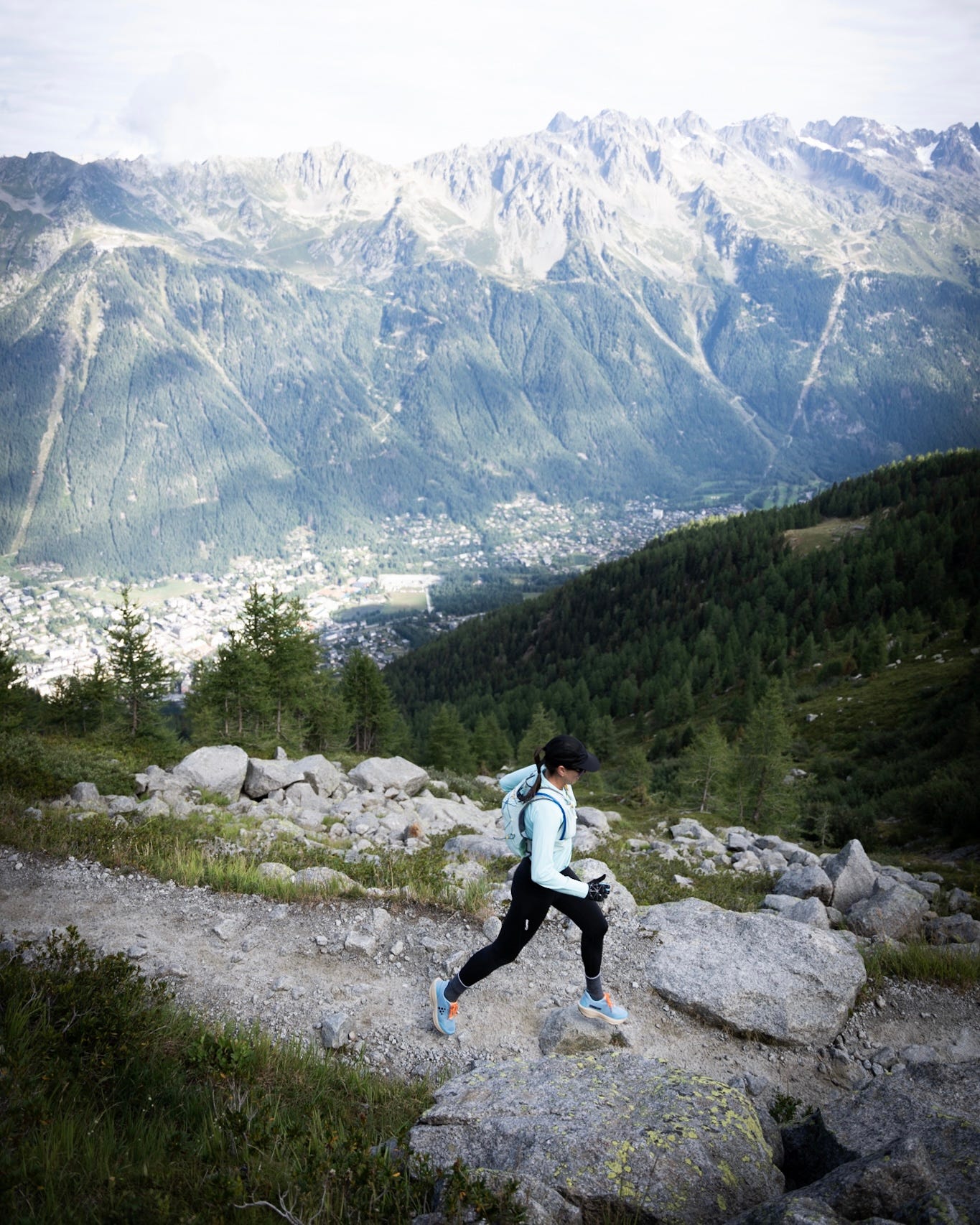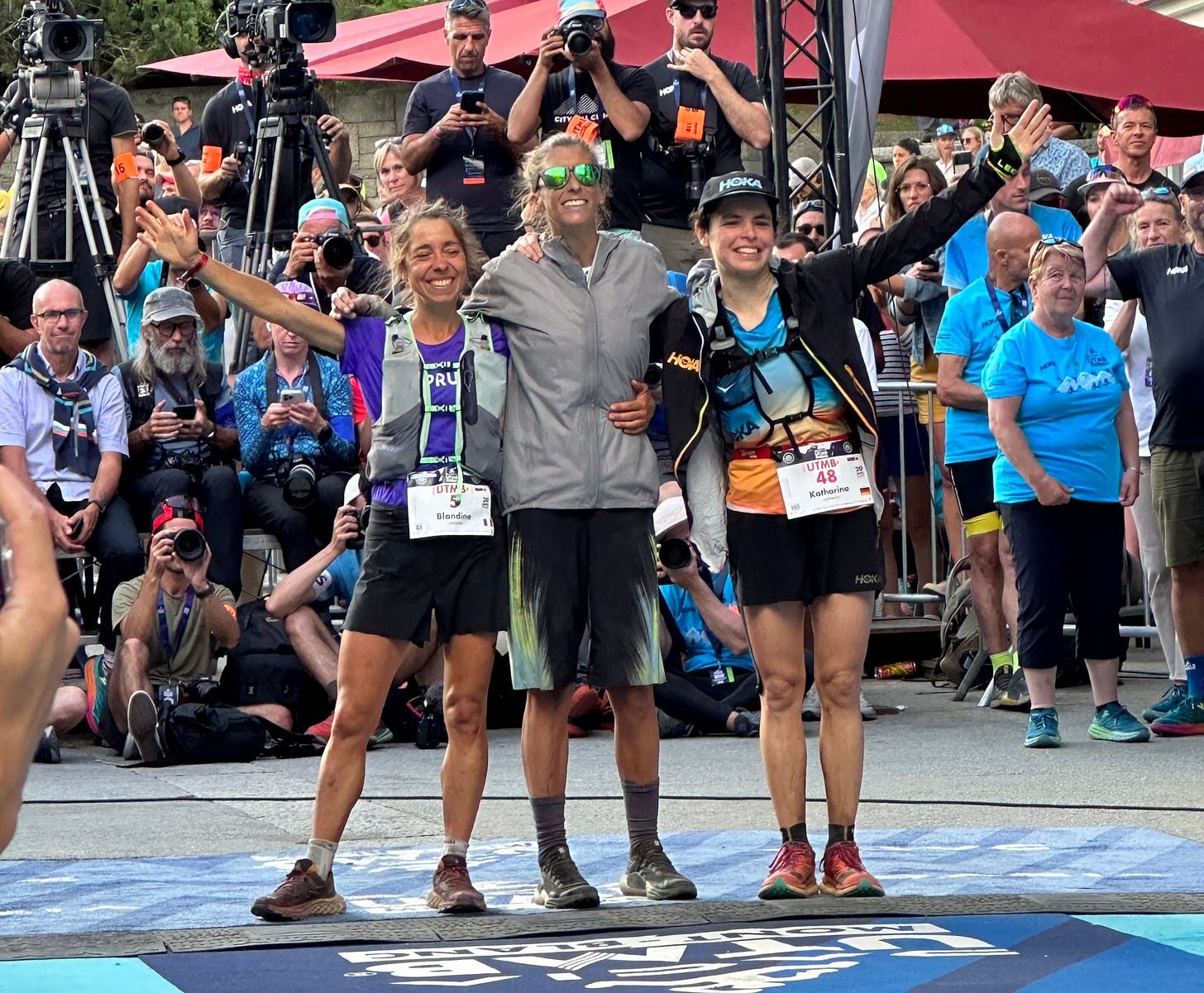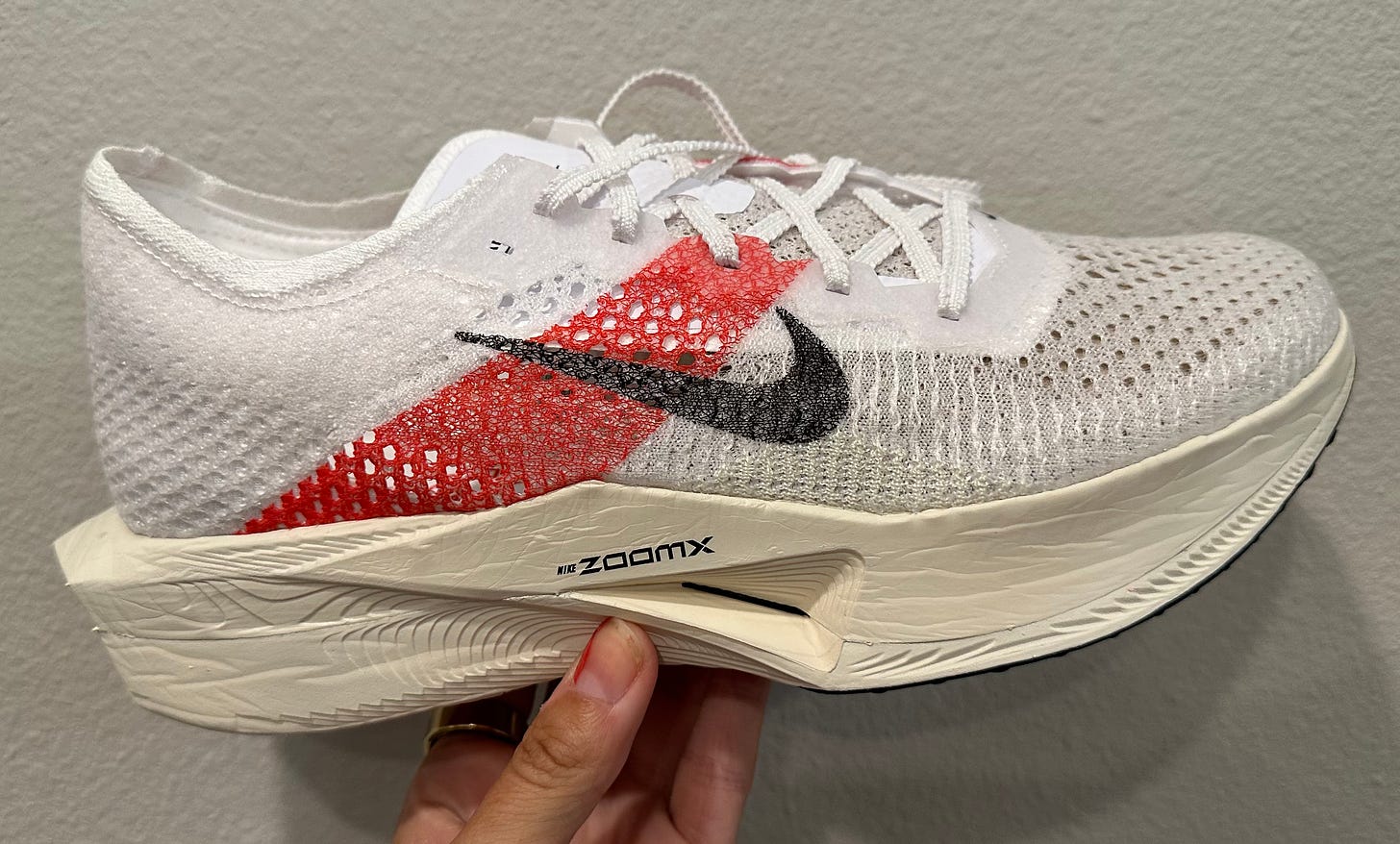UTMB Recap
Turns out, spectating an ultramarathon is a different kind of ultramarathon.
Remember how I said that this would be the summer of trails? I can’t think of a better way to cap it off (after starting with my very first trail race in May) than with trail ultrarunning’s biggest event of the year.
Earlier this summer, Craft—a Swedish sportswear brand—invited me to join them in Chamonix for the Ultra-Trail du Mont-Blanc, a 107-mile ultramarathon with 32,700 feet of total elevation gain that follows the route of the Tour du Mont Blanc through the Alps, circumnavigating Mont Blanc in France, Italy, and Switzerland. Since it started 20 years ago, UTMB has become the pinnacle event in trail racing. (There are eight other races throughout the week as well.)
Craft was there to launch the new Pure Trail running shoe. A lightweight, responsive trail shoe, it has a Cr Foam™ midsole made from a nitrogen-infused foam so you get a lot of cushioning and rebound. But with a lower stack height, rock plate, and a wider midfoot and heel, there’s a lot of inherent stability that, along with a lugged outsole made from a proprietary rubber, makes this an option for nearly every type of terrain (it was specifically designed for Americans to bomb downhill). The TPU mesh upper is a little loose and requires tight lacing, and the rubber isn’t quite as grippy as a Vibram outsole, but I put these to work on some gnarly trails and found them to be comfortable right out of the box.
To understand what a feat UTMB is, first you have to understand the terrain around Mont Blanc—which, of course, we tested firsthand while wearing the Pure Trail. Here’s the most important thing I learned while trail running in Chamonix: Don’t trust anyone tells you the trails there are runnable.
On our first run, we took the Aiguille du Midi Cable Car up to 7,600 feet, where we were treated to panoramic views of some of the most famous peaks in the Alps. This was by far the most stunning trail I’ve ever run. You know how people describe trail running as frolicking in the montains? This was the first time I’ve felt that way. The trail itself was a rolling beauty, criss-crossing glacial streams and dotted with micro-wildflowers. We weren’t moving fast, partly due to the rocks and roots littering the trail, but also because it’s nearly impossible not to stop every quarter-mile to take in the views. The run peaked right at the end of the Leschaux glacier, where a cogwheel train takes you from Montenvers station back to Chamonix. We opted to run down, winding through the pine trees as we descended nearly 5,000 feet.
On my second run, I joined friends on the opposite side of the valley, taking the La Flégère lift up to the final checkpoint on the UTMB course and “running” towards Argentière. I put running in quotes because this was more of a hike; with 1,138 feet of climbing, we were rock scrambling more than we were running, and the 3,136-foot descent included footholds bolted into the rock, metal ladders, and steel cables. RIP, my quads.
The point: This terrain is seriously challenging. Even the more “runnable” sections require a serious amount of focus and mental energy, and I can’t imagine navigating them in the dark (which most of the sub-elite UTMB runners do twice, since the race starts at 6 p.m. and can take up to 46 and a half hours) and with so many miles and climbing already on my legs.
But, again, UTMB is the Boston Marathon of trail ultramarathons. Runners train for years to earn their spot here—and they do have to earn it. In order to enter the lotter, you must have a valid UTMB index in the 100-kilometer or 100-mile categories (which means you’ve completed at least one UTMB World Series race or UTMB Index Race in the relevant category within the past two years) as well as at least one Running Stone (runners earn running stones by finishing a 20K, 50K, 100K or 100M race of the UTMB World Series circuit, and the more stones you have, the higher your chances in the lottery).
This year, nearly 2,600 runners toed the start line in Chamonix. And the start line was wild. Spectators began lining up hours in advance to watch the runners come through town, and the hype was off the charts. There are no corrals, no waves; when the French national anthem is done playing, the runners are let loose, and watching over two thousand kitted out races take to the narrow streets—made even narrower by the hordes of supporters—was really something. I wish I could say I saw Jim Walmsley or Courtney Dauwalter in the start, but the only athlete I could pick out of the crowd was one dressed as a Viking.
Once the runners left Chamonix, they headed anticlockwise to Saint Gervais, Les Contamines, La Balme, Les Chapieux, and Lac Combal before descending to Courmayeur; we opted to skip that side of the race due to rumors of horrible traffic (the rumors were true), and waited until the next morning for the runners to make their way over Grand Col Ferret—the highest peak of the race—and through La Fouly to Triente, a tiny Swiss town mostly dominated by a large pink church.
After checking out the aid station, we headed uphill for a closer view of the runners. We weren’t the only ones; it was exciting to see how many people come out to these remote towns and trek through the mountains just for a chance to support the runners. Shortly after we arrived, Jim Walmsley came through in the lead, followed closely by Zack Miller and French athlete Germain Grangier. These guys were moving, especially considering they were at the start of a 3,200-foot climb. After the top three men passed, we hustled out of Trient and back to France. (Unfortunately, the gap between the top men and top women meant we couldn’t stick around for Courtney if we wanted to see the men at the finish line).
In the picturesque ski town of Vallorcine, we caught Walmsley coming across the bridge and into the aid station, where he barely paused before heading back out. The crowds were absolutely rabid, watching him refuel and restock in silence (which is honestly kind of weird) and breaking into a roar as he left the tent. Zach Miller followed around 15 minutes later, and it was kind of funny to watch all the photographers and videographers trailing him on foot and on bikes—I didn’t realize how much of a role content creators, from documentarians to brand photographers to videographers live streaming the race, played in each athletes’ journey. (I need to know more about how people qualify for these jobs!)
From there, it’s only about 10K back to La Flégère, and then a four-mile descent back into Chamonix, so we hustled ourselves back to town in order to get a prime spot in the media area at the finish line. We didn’t have to wait long: 19 hours and 37 minutes and 43 seconds after the start, Jim Walmsey broke the metaphorical tape, becoming the first American man to win UTMB and setting a new course record in the process. It was a historic win, but one that should be considered in context: American women have won the last four UTMB races, plus five more times in its 20-year history. When asked about how his victory felt, Walmsley nodded to that record, saying, “I’m just happy to stand on their shoulders.” Zach Miller arrived a mere 20ish minutes later with a sprint to the finish, earning second in 19:58:58.
While the men’s race was exciting, as soon as the top three finished, all attention turned to the real star of the weekend. Courtney Dauwalter—who looked like the Pied Piper on the course, with hordes of fans following her every step of the way—took first in 23:29:14 (future races might want to consider a bodyguard for her). It was her third UTMB win (she won in 2019 and 2021), but more importantly, it was her third 100-mile race win this summer, after she won and set course records at Western States in June and Hard Rock in July. No trail runner, male or female, has ever accomplished this trifecta, and her win cements Courtney as the kind of athlete that transcends gender when it comes to pushing the limits of sport. Honestly, it gave me chills to watch her cross that finish line.
Germany’s Katharina Hartmuth—this year’s Trail World Championships 80k second-place woman—and France’s Blandine L’Hirondel—a two-time trail world champion—came in at 24:10:52 and 24:22:50 after a much tighter race (when Courtney’s running, you’re basically competing for second and third), which also made for exciting viewing.
We stayed at the finish line for hours, and I came back out around 2 a.m. to watch a friend finish. Runners had 46 and a half hours to finish this race, so there was a near constant stream of finishers making their way back into town. The emotions at the finish line ran the gamut, from ecstasy to agony and everything in between. There were runners who looked disconcertingly fresh for having just completed 107 miles—some even managed fancy footwork or a jump for the camera—and runners who weeble-wobbled their way down the blue carpet. Some runners egged on the crowd (my favorite was one who chugged a beer), and some runners collapsed to the ground in slow motion.
Getting to experience UTMB gave me a whole new appreciation for the physical and mental toughness an ultramarathon requires. It’s always exciting to watch humans accomplish incredible things, whether they’re making history or just attempting something big and scary.
But Dauwaulter’s performance stood out to me in a couple of ways. UTMB is overwhelmingly male, with women making up just 21.5 percent of the field in all eight events, not just the 107-mile race. This unprecedented hat trick gives her the kind of mainstream appeal that could draw new attention—and new female athletes—to the sport. I hope it does! But at the same time, I hope people don’t try to normalize this kind of hat trick. Even Dauwalter acknowledged the toll it took on her in her post-race interview, saying she planned to take a long break to “make sure all the reserves are filled back up, mentally, physically, and emotionally.” The human body is capable of incredible things, as all these athletes proved this week. But if you want to keep chasing the impossible, you have to respect the body and what it needs, and I hope she doesn’t shy away from addressing that in all the inevitable post-race coverage.
the rundown
Nike Kipchoge Collection
To honor Eluid Kipchoge, the greatest marathoner of all time, Nike just launched the EK Umoja Collection. The footwear and apparel—which include the Alphafly 2, Vaporfly 3, Zoom Fly 5, Pegasus 40, and Victory track spike, as well as the Windrunner jacket, Rise 365 tee, Stride 7-inch short, and a Dri-FIT tee—honor Kipchoge’s career and legacy within the running community; Umoja means “unity” in Swahili, and the colors and graphics pay homage to the start of Kipchoge’s elite racing career 20 years ago (his first World Championship in the 5,000 meters in Paris), as well as his Kenyan heritage. The limited-edition products are on sale now.
Do Wearables Actually Change Our Behaviors for the Better?
When it comes to wearables, there’s a disconnect between perception and reality. Users who self-reported improving their sleep habits because of their device didn’t actually show any measurable improvements in sleep over the course of nearly a year, according to an August paper from the IFIP Conference on Human-Computer Interaction. Look, as much as I love all my wearables, I do think most lack nuance and could do a better job helping wearers interpret the data. Just strapping on a Fitbit doesn’t make you fitter; you have to do the work when it comes to understanding your behaviors and adjusting your lifestyle accordingly.
Adidas Prime X 2 Strung
I kind of love how Adidas is leaning into the “illegally fast” promos, but I’m not sure if they deliver. I wore the Adidas Prime X Strung in the Berlin Marathon last year (and did not PR), so I was excited to see how the brand improved upon it. It now has three layers of Lightstrike Pro foam (and maintains a stack height of 50 mm), which sandwich two carbon-infused plates. It also has a much more comfortable stretch knit tongue, and a slightly wider forefoot, which makes it more stable overall (thank god). However, it’s still going to be more unstable than lower shoes, and—just like with the first version—it’s a little bottom heavy, which may slow you down. I haven’t run long in this one yet, but I’m not 100% convinced it’s the PR shoe Adidas promises.






